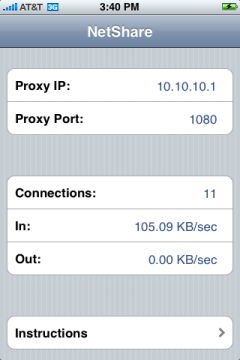development:
adapter: mysql
database: legaltorrents_development
username: fred
password: password
socket: /tmp/mysql.sock
production:
adapter: postgresql
database: legaltorrents_production
username: fred
password: password
host: localhost
Thanks to Ruby on Rails, transferring and converting database from one database platform to another only takes a few lines of code. There are rake tasks for dumping to YAML and back. However the existing YAML scripts I found had issues with some of our data and then failed for blobs. This script will only work with a “rails style” database. By “rails style” I mean any database where every table has a unique key named “id”.
A special thanks to Matson Systems, Inc. for having me write this script for LegalTorrents and then contribute it to all under a BSD license.
Be sure to read the warnings in script. Here is a complete example converting a production postgresql database into a development mysql database. Let’s start with
config/database.yml found to the left.
Now both schemas must be identical. For this example let’s ensure both schemas are at the same migration:
1 2 |
rake db:migrate env RAILS_ENV=production rake db:migrate |
1 2 3 4 5 |
cd lib/tasks wget 'http://github.com/face/rails_db_convert_using_adapters/tree/master%2Fconvert.rake?raw=true' -O convert.rake # and run it rake db:convert:prod2dev |
Update Oct 1, 2008:Fixed a bug today for Rails 2.1.1. Also got rid of the hash of data that was a relic from an early version of the script that used a single model object.
Here is the full code to convert.rake:
1 2 3 4 5 6 7 8 9 10 11 12 13 14 15 16 17 18 19 20 21 22 23 24 25 26 27 28 29 30 31 32 33 34 35 36 37 38 39 40 41 42 43 44 45 46 47 48 49 50 51 52 53 54 55 56 57 58 59 60 61 62 63 64 65 66 67 68 69 70 71 72 73 74 75 76 77 78 79 80 81 82 83 84 85 86 87 88 89 90 91 92 93 94 95 96 97 98 99 100 101 102 103 104 105 106 107 108 109 110 111 112 113 114 |
# # Convert/transfer data from production => development. This facilitates # a conversion one database adapter type to another (say postgres -> mysql ) # # WARNING 1: this script deletes all development data and replaces it with # production data # # WARNING 2: This script assumes it is the only user updating either database. # Database integrity could be corrupted if other users where # writing to the databases. # # Usage: rake db:convert:prod2dev # # It assumes the development database has a schema identical to the production # database, but will delete any data before importing the production data # # A couple of the outer loops evolved from # http://snippets.dzone.com/posts/show/3393 # # For further instructions see # http://myutil.com/2008/8/31/rake-task-transfer-rails-database-mysql-to-postgres # # The master repository for this script is at github: # http://github.com/face/rails_db_convert_using_adapters/tree/master # # # Author: Rama McIntosh # Matson Systems, Inc. # http://www.matsonsystems.com # # This rake task is released under this BSD license: # # Copyright (c) 2008, Matson Systems, Inc. All rights reserved. # # Redistribution and use in source and binary forms, with or without # modification, are permitted provided that the following conditions # are met: # # * Redistributions of source code must retain the above copyright # notice, this list of conditions and the following disclaimer. # * Redistributions in binary form must reproduce the above copyright # notice, this list of conditions and the following disclaimer in the # documentation and/or other materials provided with the distribution. # * Neither the name of Matson Systems, Inc. nor the names of its # contributors may be used to endorse or promote products derived # from this software without specific prior written permission. # # THIS SOFTWARE IS PROVIDED BY THE COPYRIGHT HOLDERS AND CONTRIBUTORS # "AS IS" AND ANY EXPRESS OR IMPLIED WARRANTIES, INCLUDING, BUT NOT # LIMITED TO, THE IMPLIED WARRANTIES OF MERCHANTABILITY AND FITNESS # FOR A PARTICULAR PURPOSE ARE DISCLAIMED. IN NO EVENT SHALL THE # COPYRIGHT OWNER OR CONTRIBUTORS BE LIABLE FOR ANY DIRECT, INDIRECT, # INCIDENTAL, SPECIAL, EXEMPLARY, OR CONSEQUENTIAL DAMAGES (INCLUDING, # BUT NOT LIMITED TO, PROCUREMENT OF SUBSTITUTE GOODS OR SERVICES; # LOSS OF USE, DATA, OR PROFITS; OR BUSINESS INTERRUPTION) HOWEVER # CAUSED AND ON ANY THEORY OF LIABILITY, WHETHER IN CONTRACT, STRICT # LIABILITY, OR TORT (INCLUDING NEGLIGENCE OR OTHERWISE) ARISING IN # ANY WAY OUT OF THE USE OF THIS SOFTWARE, EVEN IF ADVISED OF THE # POSSIBILITY OF SUCH DAMAGE. # PAGE_SIZE is the number of rows updated in a single transaction. # This facilitates tables where the number of rows exceeds the systems # memory PAGE_SIZE=10000 namespace :db do namespace :convert do desc 'Convert/import production data to development. DANGER Deletes all data in the development database. Assumes both schemas are already migrated.' task :prod2dev => :environment do # We need unique classes so ActiveRecord can hash different connections # We do not want to use the real Model classes because any business # rules will likely get in the way of a database transfer class ProductionModelClass < ActiveRecord::Base end class DevelopmentModelClass < ActiveRecord::Base end skip_tables = ["schema_info", "schema_migrations"] ActiveRecord::Base.establish_connection(:production) (ActiveRecord::Base.connection.tables - skip_tables).each do |table_name| ProductionModelClass.set_table_name(table_name) DevelopmentModelClass.set_table_name(table_name) DevelopmentModelClass.establish_connection(:development) DevelopmentModelClass.reset_column_information ProductionModelClass.reset_column_information DevelopmentModelClass.record_timestamps = false # Page through the data in case the table is too large to fit in RAM offset = count = 0; print "Converting #{table_name}..."; STDOUT.flush # First, delete any old dev data DevelopmentModelClass.delete_all while ((models = ProductionModelClass.find(:all, :offset=>offset, :limit=>PAGE_SIZE)).size > 0) count += models.size offset += PAGE_SIZE # Now, write out the prod data to the dev db DevelopmentModelClass.transaction do models.each do |model| new_model = DevelopmentModelClass.new(model.attributes) new_model.id = model.id new_model.save(false) end end end print "#{count} records converted\n" end end end end |


